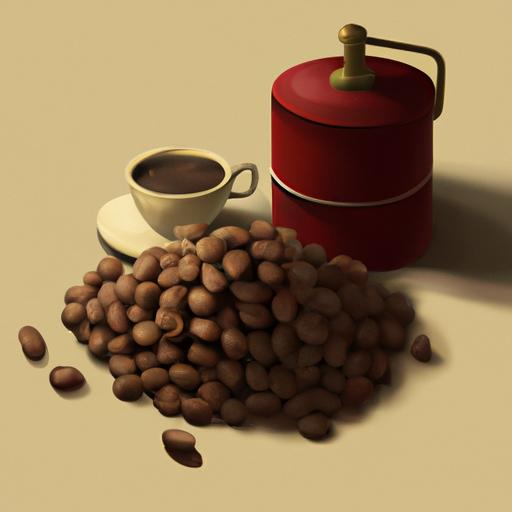Coffee lovers, rejoice! Robusta coffee is a unique and flavorful variety of coffee that is gaining in popularity.
Have you ever wondered what makes Robusta coffee different from other coffees? From its origins and flavor profile to its caffeine content, potential health benefits, and potential drawbacks, this guide will provide a comprehensive overview of Robusta coffee.
Let’s explore its history, where it is grown, the flavor profile, caffeine content, uses, and benefits of Robusta coffee.
Table of Contents
Short Answer
Robusta coffee is a coffee bean variety that is commonly used for making espresso, and is known for its full-bodied flavor and intense aroma.
It is usually slightly more acidic than Arabica coffee, and it also has a higher caffeine content.
Robusta beans are usually less expensive than Arabica beans, so they are often used in blends to lower the cost of the coffee.
History of Robusta Coffee
Robusta coffee has been around for centuries, with its origins originating in the tropical regions of Africa, Asia, and Indonesia.
It was first discovered by Dutch colonialists in the 19th century who were looking for a cheaper and more resilient alternative to the more expensive Arabica coffee beans.
Robusta coffee was found to be more resistant to pests and disease and had a stronger flavor and higher caffeine content than its Arabica counterpart.
Since then, Robusta coffee has become a staple in many coffee blends around the world.
It is commonly used in espresso blends, instant coffee, and commercial coffee blends due to its low cost and robust flavor.
It is also often used as a filler in coffee blends in order to stretch the cost and provide a more balanced flavor.
Robusta beans are often considered to be of lesser quality than Arabica beans, though this is not necessarily true.
While Robusta coffee does have a stronger flavor and more bitterness, it can still be enjoyed as a single origin coffee or blended with other coffees in order to create a unique flavor profile.
Robusta coffee has also become popular in recent years due to its ability to be sustainably produced.
This is due to the fact that Robusta coffee is more resilient to pests and diseases, meaning it requires less fertilization and pesticides to keep it healthy.
This makes Robusta coffee a great choice for those looking for an eco-friendly coffee option.
Regions Where Robusta Coffee is Grown

Robusta coffee beans are native to tropical regions of Africa, Asia, and Indonesia.
This hearty species of coffee is known for its strong, bitter flavor and high caffeine content, which make it a popular choice for espresso blends, instant coffee, and commercial coffee blends.
Robusta coffee is also prized for its low cost in comparison to other coffee bean varieties, making it an attractive choice for coffee producers around the world.
In Africa, Robusta coffee is grown in Ethiopia, Uganda, and the Democratic Republic of the Congo.
In Asia, it is popular in India, Vietnam, and Indonesia, while in Indonesia, it is mainly grown on the islands of Java, Sumatra, and Sulawesi.
In addition, Robusta coffee is also grown in areas of Central and South America, such as Brazil, Colombia, Guatemala, and Honduras.
Robusta coffee is known for its hardy nature and resistance to temperature and drought, making it an attractive crop for farmers in the tropics.
It is also less susceptible to disease and pests, which makes it a more reliable crop than other types of coffee.
In addition, Robusta coffee is relatively easy to cultivate and harvest, making it an attractive choice for coffee producers.
Flavor Profile of Robusta Coffee
Robusta coffee is known for its intense flavor profile, with strong notes of bitterness and a robust, earthy taste.
It is also notable for its high caffeine content, which is roughly double that of Arabica coffee beans.
With a bold flavor and a strong aroma, Robusta beans are often used to add intensity to espresso blends and commercial coffee blends.
The beans are also often used in instant coffee due to their low cost and ease of preparation.
When brewed, Robusta coffee has a much stronger and more intense flavor than Arabica coffee.
It has a bitter, earthy taste with notes of dark chocolate, and a distinct sweetness that lingers on the tongue.
It is also much more aromatic than Arabica coffee, with a robust aroma that is often described as smoky or woody.
Robusta coffee is also known for its higher caffeine content, which can be up to twice that of Arabica coffee.
This makes it a popular choice for those looking for a strong and invigorating cup of coffee.
For those who are sensitive to caffeine, however, Robusta coffee may be too strong and should be avoided.
Overall, Robusta coffee is one of the most unique and flavorful coffee beans available.
With its intense flavor profile, robust aroma, and high caffeine content, it is an excellent choice for those looking for an intense and flavorful cup of coffee.
Caffeine Content of Robusta Coffee

The most notable feature of Robusta coffee beans is their higher caffeine content, typically double that of Arabica beans.
Robusta coffee tends to have about 2.7% caffeine by weight, compared to 1.5% for Arabica.
This makes Robusta beans ideal for espresso blends and commercial coffee production, as the higher caffeine content helps to give the coffee a stronger, bolder flavor.
Additionally, the higher caffeine content of Robusta beans can provide an extra kick of energy for those who need it.
However, it is important to note that the caffeine content of a particular batch of Robusta beans can vary greatly depending on the type of plant, soil conditions, and other factors.
Therefore, if you are looking for a certain level of caffeine in your coffee, it is important to make sure you are purchasing the right variety of Robusta beans.
In addition, it can be helpful to have the beans tested for their caffeine content before using them in your coffee.
Uses of Robusta Coffee
Robusta coffee beans are becoming increasingly popular, with more and more coffee drinkers around the world discovering this unique and flavorful variety of coffee.
Robusta coffee is known for its strong, bitter flavor and higher caffeine content compared to other coffee beans.
Because of this, it is commonly used in espresso blends, instant coffee, and commercial coffee blends.
Robusta coffee is also often used as a base for many coffee drinks, such as lattes, cappuccinos, and macchiatos.
It adds a strong, robust flavor to these beverages, as well as a boost of caffeine to help keep you awake and energized.
Robusta coffee is also used to make cold brew coffee and other cold drinks, as it adds a unique flavor profile that is not found in other coffee beans.
Robusta coffee is also used in many coffee-flavored desserts, such as ice cream and cake.
The strong flavor of the coffee beans lends itself perfectly to these sweet treats, adding a unique depth of flavor that cant be found in other types of coffee.
Not only is Robusta coffee delicious, but it is also a great way to get a caffeine boost.
Robusta coffee has twice as much caffeine as Arabica coffee beans, so it is a great way to get an extra energy boost when you need it.
For this reason, Robusta coffee is a great choice for those who need an extra boost of energy in the morning or throughout the day.
Overall, Robusta coffee is a great choice for those who want a strong, bitter flavor and an extra boost of caffeine.
It is perfect for espresso blends, cold brews, and coffee-flavored desserts.
Plus, it is a great way to get an extra energy boost when you need it.
Benefits of Robusta Coffee

Robusta coffee is a powerhouse of flavor and energy, and there are several reasons why it’s become so popular in recent years.
First, Robusta beans contain more caffeine than Arabica beans, making them an ideal choice for those who need an extra boost of energy in the morning or throughout the day.
This higher caffeine content also gives Robusta beans a stronger, more bitter flavor than the milder Arabica beans, which makes them well suited for use in espresso-based drinks and for those who like a bolder cup of coffee.
Robusta beans also tend to be more resistant to disease and pests than Arabica beans, which means they require less pesticides and herbicides and are less likely to be affected by climate change.
This makes them a great choice for coffee producers who are looking for a sustainable and eco-friendly crop.
In addition, Robusta beans are generally much cheaper than Arabica beans, making them an economical choice for coffee retailers and consumers alike.
Finally, Robusta beans are much easier to cultivate than Arabica beans.
The trees require less maintenance, can be grown in a wider range of climates, and have shorter harvest cycles, which means they can produce more coffee beans in a shorter period of time.
This makes Robusta coffee a great choice for large-scale commercial production and for those who want to enjoy a cup of coffee without breaking the bank.
Potential Drawbacks of Robusta Coffee
Despite its strong flavor, Robusta coffee is not without its drawbacks.
For one, it is not as popular as Arabica coffee beans.
Robusta coffee is known for having a strong, bitter flavor that is not as pleasing to some coffee drinkers.
Additionally, Robusta coffee is higher in caffeine than other types of coffee beans, which may not be ideal for those who are sensitive to caffeine.
Lastly, Robusta coffee is not as complex as Arabica coffee, as it does not have as many notes and nuances in flavor.
This can make it difficult for some people to appreciate the unique flavor of Robusta beans.
Final Thoughts
Robusta coffee is a unique species of coffee bean that has a bold, bitter flavor and higher caffeine content than other types of coffee beans.
While not as popular as Arabica coffee beans, Robusta beans are still widely used in coffee production around the world.
From its history to its uses, Robusta coffee is an interesting variety of coffee bean that has a lot to offer.
Now that you know more about Robusta coffee, why not try brewing a cup of your own to see what you think?

